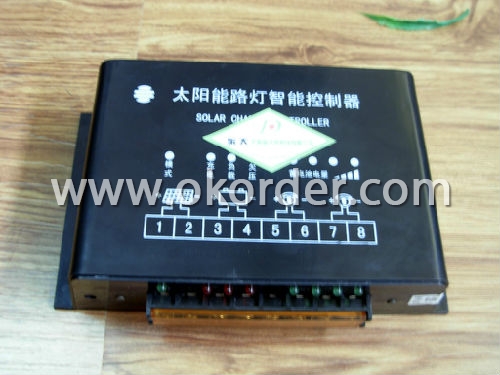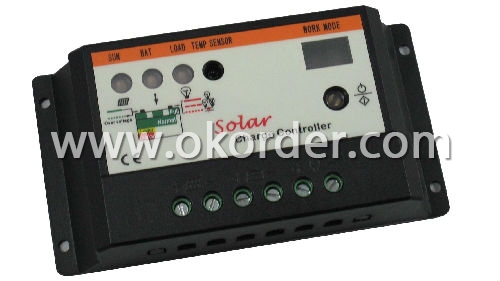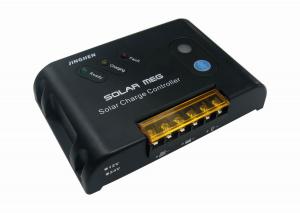L-Series PV Controller
- Loading Port:
- Nanjing
- Payment Terms:
- TT/LC
- Min Order Qty:
- 50sets set
- Supply Capability:
- 1-3000sets/month set/month
OKorder Service Pledge
OKorder Financial Service
You Might Also Like
Specification of L-Series PV Controller
Professional MCU microprocessor control, the real charge and discharge of intelligent control;
Low-loss, long-life MOSFET switching devices as the main controller;
PV charging(PWM) technology, a higher charging efficiency;
Operating status, fault LED indicates the;
Control modes: light control switch control mode / off light control to open when the control mode / automatic light control mode when the control;
Absorb the output circuit with inductive load;
Memory function, the controller re-energized after power on, automatically de-energized mode before;
Perfect protection;
Against reverse battery;
Maintenance easy, fast;
Optional Configuration of L-Series PV Controller:
RS485/RS232 Remote monitoring;
Supporting electricity can be a complementary manner to ensure uninterrupted power supply load;
Technical Data of L-Series PV Controller:
Voltage | 12V | 24V | 36V | 48V | ||
Rated current range | 5A~30A | 5A~30A | 5A~20A | 5A~20A | ||
Battery input | ||||||
Rated input voltage (VDC) | 12 | 24 | 36 | 48 | ||
Under voltage protection (VDC) | ≤10.8 | ≤21.6 | ≤32.4 | ≤43.2 | ||
Recovery voltage (VDC) | ≥12.3 | ≥24.6 | ≥36.9 | ≥49.2 | ||
Overvoltageprotection (VDC) | ≥16.5 | ≥33.0 | ≥49.5 | ≥66.0 | ||
Overvoltage recovery (VDC) | ≤15.0 | ≤30.0 | ≤45.0 | ≤60.0 | ||
Solar energy input | ||||||
Max. open circuit voltage (VDC) | 25.0 | 50.0 | 75.0 | 100.0 | ||
Light control open, turn off the lights | Voltage light(VDC) | ≤3.5 | ≤7.0 | ≤10.5 | ≤14.0 | |
Voltage light (VDC) | ≥7.0 | ≥14.0 | ≤21.0 | ≤28.0 | ||
Float voltage (VDC) | 13.7 | 27.4 | 41.1 | 54.8 | ||
Overcharge protection voltage (VDC) | ≥14.4 | ≥28.8 | ≥43.2 | ≥57.6 | ||
Charge recovery voltage (VDC) | ≤13.2 | ≤26.4 | ≤39.6 | ≤52.8 | ||
DC output | ||||||
Number of outputs(N) | 2 | |||||
Rated output current | load1 (A) | 2.5~15 | 2.5~15 | 2.5~10 | 2.5~10 | |
load2 (A) | 2.5~15 | 2.5~15 | 2.5~10 | 2.5~10 | ||
Overvoltage capacity | 120% overload 60 seconds off the output / 150% overload for 10 seconds to close the output | |||||
Control mode | Light control mode / time control mode / automatic control mode | |||||
Serial communication | RS485(A、B) | |||||
Mechanical dimensions, the work environment | ||||||
Size ( D x W x H ) | 230 x 145 x 75 | |||||
Reference weight (Kg) | 6 | |||||
Protection level | IP41 | |||||
Max. working altitude (m) | ≤3000 | |||||
Temperature range (℃) | -20 ~ +65 | |||||

L-Series PV Controller

L-Series PV Controller
Packaging & Delivery of L-Series PV Controller
Packaging: Wooden box or Customized
Delivery: Depends on the quantity or Customized
- Q:Can a solar controller be used with solar-powered indoor educational institutions?
- Solar controllers are capable of being utilized in solar-powered indoor educational institutions. These devices regulate the voltage and current from the solar panels, ensuring proper battery charging and preventing overcharging. Moreover, in indoor educational institutions that rely on solar energy, a solar controller can be employed to monitor and manage the power generated by the solar panels. This facilitates the maintenance of optimal battery charging levels, which store solar energy for use during periods without sunlight or when electricity demand exceeds current solar generation. By utilizing a solar controller, indoor educational institutions can effectively manage and utilize solar power, ensuring uninterrupted power supply and reducing dependence on the grid. Furthermore, solar controllers also contribute to extending battery lifespan by preventing overcharging or deep discharging, which can negatively impact battery performance. Consequently, it is highly recommended to utilize a solar controller in indoor educational institutions powered by solar energy to optimize system efficiency and reliability.
- Q:How does a solar controller protect against short circuits?
- A solar controller protects against short circuits by continuously monitoring the electrical current flowing from the solar panels to the battery. If a short circuit occurs, the controller immediately detects the sudden increase in current and automatically shuts off the flow of electricity, preventing any damage to the solar panels or other connected components.
- Q:Can a solar controller be used with solar-powered pool heaters?
- Yes, a solar controller can be used with solar-powered pool heaters. A solar controller helps regulate and optimize the performance of the solar panels by managing the flow of energy from the panels to the pool heater. It monitors and adjusts the temperature, ensuring efficient heating and preventing overheating. By using a solar controller, pool owners can maximize the benefits and effectiveness of their solar-powered pool heaters.
- Q:How does a solar controller handle battery temperature monitoring and protection?
- A solar controller handles battery temperature monitoring and protection by constantly monitoring the temperature of the battery. This is typically done by using a built-in temperature sensor or by connecting an external temperature sensor to the controller. The controller measures the temperature of the battery and compares it to a predefined temperature range. If the temperature falls outside of this range, the controller takes appropriate actions to protect the battery. If the temperature exceeds the upper limit, the controller may reduce the charging current or completely disconnect the solar panels from the battery to prevent overcharging and potential damage. This is important because high temperatures can lead to accelerated battery aging and reduced battery life. On the other hand, if the temperature drops below the lower limit, the controller may adjust the charging voltage to prevent undercharging. Cold temperatures can significantly affect the battery's performance and capacity, so it is crucial to ensure proper charging in such conditions. In addition to these protective measures, some advanced solar controllers may also offer temperature compensation. They adjust the charging parameters based on the battery temperature to optimize charging efficiency and prolong battery life. This compensation is particularly valuable as it helps to counteract the temperature-related variations in battery chemistry and performance. Overall, through continuous temperature monitoring and appropriate protective actions, a solar controller ensures that the battery operates within a safe temperature range, maximizing its lifespan and optimizing its performance.
- Q:Can a solar controller be used with a solar-powered pool heating system?
- Yes, a solar controller can be used with a solar-powered pool heating system. A solar controller helps regulate and optimize the performance of the solar panels, ensuring they efficiently capture and convert sunlight into heat for the pool. It allows for monitoring and adjustment of temperature settings, as well as the ability to control the flow of water through the system, maximizing its effectiveness.
- Q:What is the purpose of the low voltage disconnect feature on a solar controller?
- In order to safeguard the batteries from over-discharge, the low voltage disconnect feature on a solar controller serves a crucial purpose. When the battery's voltage drops below a certain level, irreversible damage can occur, significantly reducing its lifespan. By monitoring the battery voltage, the low voltage disconnect feature effectively disconnects any load, such as appliances or devices, from the battery once the voltage falls below a predetermined threshold. This action prevents excessive drainage of the battery, ensuring that it retains a sufficient charge for proper functioning and longevity. Consequently, by disconnecting the load, the low voltage disconnect feature plays a vital role in protecting and optimizing the battery's performance within a solar power system.
- Q:What is the communication protocol supported by a solar controller?
- The communication protocol supported by a solar controller is typically Modbus, which allows for data exchange and control between the solar controller and other devices in the solar power system.
- Q:Can a solar controller be used with solar-powered indoor aquaponics systems?
- Yes, a solar controller can be used with solar-powered indoor aquaponics systems. A solar controller helps regulate and manage the power generated by solar panels, ensuring optimal charging and usage of batteries. In an indoor aquaponics system, where sunlight may be limited, a solar controller can help maximize the efficiency of solar power utilization, providing a sustainable and eco-friendly solution for powering the system.
- Q:Are there any safety precautions I should take when using a solar controller?
- Yes, there are several safety precautions to consider when using a solar controller. Firstly, it is important to ensure that the solar controller is installed and wired correctly according to the manufacturer's instructions. This includes connecting the solar panels and batteries properly and securely. Additionally, it is crucial to use proper grounding techniques and follow electrical safety guidelines to prevent electrical shocks or fires. Furthermore, it is recommended to regularly inspect the solar controller for any signs of damage or wear, and to keep it away from water or other potentially hazardous environments. Lastly, it is advisable to familiarize yourself with the solar controller's manual and safety guidelines to ensure safe and efficient operation.
- Q:How does a solar controller handle battery short-circuit protection?
- A solar controller handles battery short-circuit protection by incorporating built-in circuitry that detects and reacts to short-circuits in the battery. When a short-circuit is detected, the controller immediately interrupts the flow of current to prevent any damage or potential hazards. This protection mechanism ensures the safety and longevity of the battery and the solar system as a whole.
1. Manufacturer Overview |
|
|---|---|
| Location | Hefei,China |
| Year Established | 2004 |
| Annual Output Value | Above US$0.6 billion |
| Main Markets | Australia;Italy;Germany;U.K. England;Franch;NewZealand; |
| Company Certifications | Growatt5000;VDE0126;SAA;G83;TUV |
2. Manufacturer Certificates |
|
|---|---|
| a) Certification Name | |
| Range | |
| Reference | |
| Validity Period | |
3. Manufacturer Capability |
|
|---|---|
| a)Trade Capacity | |
| Nearest Port | Shenzhen |
| Export Percentage | 0.4 |
| No.of Employees in Trade Department | 10 People |
| Language Spoken: | English;Chinese;French;German |
| b)Factory Information | |
| Factory Size: | Above 15,000 square meters |
| No. of Production Lines | Above 5 |
| Contract Manufacturing | OEM Service Offered;Design Service Offered |
| Product Price Range | Average |
Send your message to us
L-Series PV Controller
- Loading Port:
- Nanjing
- Payment Terms:
- TT/LC
- Min Order Qty:
- 50sets set
- Supply Capability:
- 1-3000sets/month set/month
OKorder Service Pledge
OKorder Financial Service
Similar products
New products
Hot products
Related keywords






























